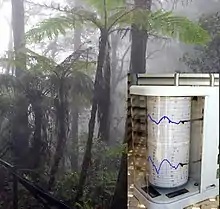Saturation vapor density
Saturation vapor density (SVD) is a concept closely tied with saturation vapor pressure (SVP). It can be used to calculate exact quantity of water vapor in the air from a relative humidity (RH = % local air humidity measured / local total air humidity possible ) Given an RH percentage, the density of water in the air is given by RH × SVD = Actual Vapor Density. Alternatively, RH can be found by RH = Actual Vapor Density ∕ SVD. As relative humidity is a dimensionless quantity (often expressed in terms of a percentage), vapor density can be stated in units of grams or kilograms per cubic meter.
| Humidity and hygrometry | |
|---|---|
 | |
| Specific concepts | |
| General concepts | |
| Measures and Instruments | |
For low temperatures (below approximately 400 K), SVD can be approximated from the SVP by the ideal gas law: P V = n R T where P is the SVP, V is the volume, n is the number of moles, R is the gas constant and T is the temperature in kelvins. The number of moles is related to density by n = m ∕ M, where m is the mass of water present and M is the molar mass of water (18.01528 grams/mole). Thus, setting V to 1 cubic meter, we get P M/R T = m/V = density.
The values shown at hyperphysics-sources[1] indicate that the saturated vapor density is 4.85 g/m3 at 273 K, at which the saturated vapor pressure is 4.58 mm of Hg or 610.616447 Pa (760 mm of Hg ≈ 1 atm = 1.01325 * 105 Pa).
Therefore, for particular mole number and volume the saturated vapor pressure will not change if the temperature remains constant.